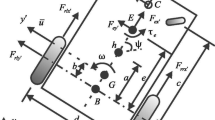Abstract
In order to improve the reliability of the robot-assisted movement training system, this paper combines the actual requirements of the robot-assisted movement training system to design the robot structure system, and optimize the structure from the kinematics point of view. In order to ensure the flexibility of the mobile platform, a steering mechanism is added to the front and rear of the mobile platform to realize its ability to steer in a small space and meet the needs of the robot in various occasions. In addition, this paper uses PID fuzzy control technology to construct the robot control system, and constructs the system's functional structure according to the actual needs of auxiliary movement training. On this basis, the performance of the robot system is analyzed. From the experimental research results, we can see that the robot-assisted movement training system based on PID control constructed in this paper has a certain effect.










Similar content being viewed by others
References
Ayari A, Bouamama S (2017) A new multiple robot path planning algorithm: dynamic distributed particle swarm optimization. Robot Biomim 4(1):1–15
Balabonski T, Delga A, Rieg L et al (2019) Synchronous gathering without multiplicity detection: a certified algorithm. Theory Comput Syst 63(2):200–218
Carius J, Wermelinger M, Rajasekaran B et al (2018) Deployment of an autonomous mobile manipulator at MBZIRC. J Field Robot 35(8):1342–1357
Cheng TCE, Kriheli B, Levner E et al (2021) Scheduling an autonomous robot searching for hidden targets[J]. Ann Oper Res 298(1):95–109
Cherni F, Rekik C, Derbel N (2019) Mobile robot navigation based on tangent circle algorithm. Int J Comput Appl Technol 59(1):31–42
El Shenawy A, Mohamed K, Harb H (2020) HDec-POSMDPs MRS exploration and fire searching based on IoT cloud robotics. Int J Autom Comput 17(3):364–377
Golan Y, Edelman S, Shapiro A et al (2017) Online robot navigation using continuously updated artificial temperature gradients. IEEE Robot Autom Lett 2(3):1280–1287
Hacene N, Mendil B (2019) Fuzzy behavior-based control of three wheeled omnidirectional mobile robot. Int J Autom Comput 16(2):163–185
Hu J, Niu H, Carrasco J et al (2020) Voronoi-based multi-robot autonomous exploration in unknown environments via deep reinforcement learning. IEEE Trans Veh Technol 69(12):14413–14423
Karakaya S, Kucukyildiz G, Ocak H (2017) A new mobile robot toolbox for MATLAB. J Intell Rob Syst 87(1):125–140
Li J, Zhu R, Chen B (2018) Image detection and verification of visual navigation route during cotton field management period. Int J Agric Biol Eng 11(6):159–165
Muthukumaran S, Sivaramakrishnan R (2019) Optimal path planning for an autonomous mobile robot using dragonfly algorithm. Int J Simul Model 18(3):397–407
Peng S, Kan Z, Li J (2017) Extraction of visual navigation directrix for harvesting operation in short-stalked and close-planting jujube orchard. Trans Chin Soc Agric Eng 33(9):45–52
Qian C, Shen X, Zhang Y et al (2018) Building and climbing based visual navigation framework for self-driving cars. Mobile Netw Appl 23(3):624–638
Unhelkar VV, Dörr S, Bubeck A et al (2018) Mobile robots for moving-floor assembly lines: Design, evaluation, and deployment. IEEE Robot Autom Mag 25(2):72–81
Victerpaul P, Saravanan D, Janakiraman S et al (2017) Path planning of autonomous mobile robots: a survey and comparison. J Adv Res Dyn Control Syst 9(12):1535–1565
Volkova A, Gibbens PW (2018) More robust features for adaptive visual navigation of UAVs in mixed environments. J Intell Robot Syst 90(1):171–187
Zhang M, Liu X, Xu D et al (2019) Vision-based target-following guider for mobile robot. IEEE Trans Industr Electron 66(12):9360–9371
Zhao R, Lee HK (2017) Fuzzy-based path planning for multiple mobile robots in unknown dynamic environment. J Electr Eng Technol 12(2):918–925
Funding
There was no outside funding or grants received that assisted in this study.
Author information
Authors and Affiliations
Corresponding author
Ethics declarations
Conflict of interest
The author declared that they have no conflicts of interest to this work. I declare that I do not have any commercial or associative interest that represents a conflict of interest in connection with the work submitted.
Additional information
Publisher's Note
Springer Nature remains neutral with regard to jurisdictional claims in published maps and institutional affiliations.
Rights and permissions
About this article
Cite this article
Wang, W. Robot-assisted movement training system based on PID control. Int J Syst Assur Eng Manag 14, 748–755 (2023). https://doi.org/10.1007/s13198-021-01546-5
Received:
Revised:
Accepted:
Published:
Issue Date:
DOI: https://doi.org/10.1007/s13198-021-01546-5




